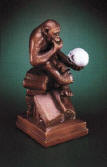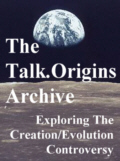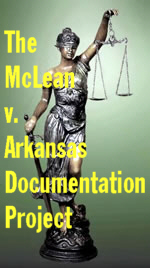
Troy Britain's
Creation/Evolution
Locus
Consider helping me defend science education by making a donation.
Thank you.
On a Common Creationist Quotation of Dr. David M. Raup
![]()
This was originally published in response to a Talk Origins Archive feedback question in June of 2001 (scroll down). It has been slightly modified.
![]()
From: Evan Yeung
Let me congratulate you on a fantastic website! I have been thoroughly impressed with the articles and information presented here. It's too bad that many of this information seems to be deliberately ignored by many people who post on this feedback board...
I do have a question...
In a number of articles that I've read from pro-creationist or intelligent design theorists, they have quoted David Raup from the Field Museum, who reportedly stated in 1979 that "We now have a quarter of a million fossil species, but the situation hasn't changed much... We have even fewer examples of evolutionary transition than we had in Darwin's time." Did David Raup really say this, or is he being taken out of context like so many other paleontologists when they are quoted by creationists?
Thanx! Evan
![]()
Yes, Raup did say this (in "Conflicts between Darwin and Paleontology", Field Museum of Natural History Bulletin Jan. 1979, Vol. 50 No. 1 p. 22-29). Here is the quote in the immediate context (the quoted portions in boldface):
Well, we are now about 120 years after Darwin and the knowledge of the fossil record has been greatly expanded. We now have a quarter of a million fossil species but the situation hasn't changed much. The record of evolution is still surprisingly jerky and, ironically, we have even fewer examples of evolutionary transitions than we had in Darwin's time. By this I mean that some of the classic cases of darwinian change in the fossil record, such as the evolution of the horse in North America, have had to be discarded or modified as a result of more detailed information -- what appeared to be a nice simple progression when relatively few data were available now appear to be much more complex and much less gradualistic. So Darwin's problem has not been alleviated in the last 120 years and we still have a record which does show change but one that can hardly be looked upon as the most reasonable consequence of natural selection. (p. 25, emphasis mine)
Note that while Raup says that some of the examples have been "discarded" he also says that others have only been "modified". For example the classic horse series Raup mentions is one of those that has been modified, but it is far from discarded. Also note that Raup clearly states that the pattern of the fossil record is one of change in living things over geologic time, something that young earth creationists deny.
And yes it has been taken out of context. The paper is about Darwin's mechanism of natural selection and whether this mechanism is reflected in pattern of the fossil record, not whether there is a lack of evidence for common descent. From the beginning of the article:
Part of our conventional wisdom about evolution is that the fossil record of past life is an important cornerstone of evolutionary theory. In some ways, this is true -- but the situation is much more complicated. I will explore here a few of the complex interrelationships between fossils and darwinian theory. . . Darwin's theory of natural selection has always been closely linked to evidence form fossils, and probably most people assume that fossils provide a very important part of the general argument that is made in favor of darwinian interpretations of the history of life. Unfortunately, this is not strictly true. We must distinguish between the fact of evolution -- defined as change in organisms over time -- and the explanation of this change. Darwin's contribution, through his theory of natural selection, was to suggest how the evolutionary change took place. The evidence we find in the geologic record is not nearly as compatible with darwinian natural selection as we would like it to be. (p. 22)
The transitions Raup seems to be talking about, in the quote creationists use, are mostly at the level of species or genera (like between a horse and a zebra or between a fox and a wolf). Not intermediates between higher classifications like between classes, orders, or families (between reptiles and mammals etc.), which are the ones creationists most object to. However it is these "missing" species level transitions that creationists (in ignorance?) often quote paleontologists talking about. This seems to be the case here as well:
There were several problems, but the principle one was that the geologic record did not then and still does not yield a finely graduated chain of slow and progressive evolution. In other words, there are not enough intermediates. There are very few cases where one can find a gradual transition from one species to another. . . (p. 23, emphasis mine)
Stephen Jay Gould and Niles Eldredge are favorite targets for this creationist tactic because their hypothesis of punctuated equilibria is intended to explain why, from a biological point of view, we should expect species level transitions to be rare in the fossil record. Thus in their writings they frequently state the problem(s) they are attempting to solve. Creationists quote them stating the problems but not the solutions they propose. This seems to be the nature of the quote they have taken from Raup. The beginning of the very next paragraph after the one they quote tends to confirm this:
Now let me take a step back from the problem and very generally discuss natural selection and what we know about it. I think it is safe to say that we know for sure that natural selection, as a process, does work. There is a mountain of experimental and observational evidence, much of it predating genetics, which shows that natural selection as a biological process works. (p. 25)
He then moves on to the fossil record:
Now with regard to the fossil record, we certainly see change. If any of us were to be put down in the Cretaceous landscape we would immediately recognize the difference. Some of the plants and animals would be familiar but most would have changed and some of the types would be totally different from those living today. . . This record of change pretty clearly demonstrates that evolution has occurred if we define evolution simply as change; but it does not tell us how this change too place, and that is really the question. If we allow that natural selection works, as we almost have to do, the fossil record doesn't tell us whether it was responsible for 90 percent of the change we see or 9 percent, or .9 percent. (p. 26)
He then goes on to discuss natural selection versus other possible explanatory mechanisms and how they might relate to the fossil record. He also discusses the effects of historical contingency as it relates to extinction pointing out that sometimes species may become extinct due more to "bad luck" than bad genes (this by the way is the basis for Raup's 1991 book Extinction - Bad Genes or Bad Luck?). Raup concludes this article stating:
The ideas I have discussed here are rather new and have not been completely tested. No matter how they come out, however, they are having a ventilating effect on thinking in evolution and the conventional dogma is being challenged. If the ideas turn out to be valid, it will mean that Darwin was correct in what he said but that he was explaining only a part of the total evolutionary picture. The part he missed was the simple element of chance! (p. 29)
Not particularly damning. Perhaps the more interesting question is where do creationists get the idea that lists of such (out of context) quotations are a valid form of scientific argument?
For Raup's views on creationist arguments I suggest you look up one or both of the following:
|
|
"Geology and Creationism", Field Museum of Natural History Bulletin Mar. 1983, Vol. 54 No. 3 pp. 16-25) |
|
|
"The Geological and Paleontological Arguments of Creationism" in Scientists Confront Creationism (1983), Laurie R. Godfrey (Editor), pp. 147-162 |
![]()



